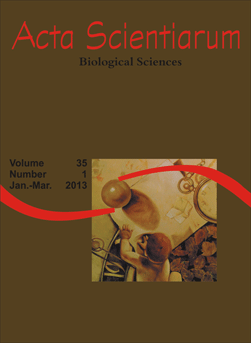<b>Medium and large sized mammal assemblages in coastal dunes and adjacent marshes in southern Rio Grande do Sul State, Brazil</b> - doi: 10.4025/actascibiolsci.v35i1.11705
Resumo
This paper presents data on species composition and use of habitat of medium and large sized mammal assemblages in a coastal dunes segment and adjacent marshes at Rio Grande municipality, southern Rio Grande do Sul State, Brazil. Records were obtained through visualization of living animals and identification of footprints, feces and remains. From November 2007 to September 2008, nine 600 m long and 5 m wide linear transects were settled on coastal dunes segment (frontal and intermediate dunes) and adjacent marshes, parallel to ocean shore on a 23 km section at Cassino Beach. Transects were settled in areas under high, medium and low levels of anthropic occupancy (A1, A2 and A3, respectively), being three transects on each area. Fourteen species were recorded, distributed in five orders and 10 families. Lepus europaeus was the most frequent species (81.9% of the transect walks), present in all areas and seasons, followed by Lycalopex gimnocercus (23.5%) and Conepatus chinga (10.3%). Five species were present on A1, seven on A2 and fourteen on A3. Seven species were recorded on frontal dunes, nine on intermediate dunes and 13 on adjacent marshes.
Downloads
DECLARAÇÃO DE ORIGINALIDADE E DIREITOS AUTORAIS
Declaro que o presente artigo é original, não tendo sido submetido à publicação em qualquer outro periódico nacional ou internacional, quer seja em parte ou em sua totalidade.
Os direitos autorais pertencem exclusivamente aos autores. Os direitos de licenciamento utilizados pelo periódico é a licença Creative Commons Attribution 4.0 (CC BY 4.0): são permitidos o compartilhamento (cópia e distribuição do material em qualqer meio ou formato) e adaptação (remix, transformação e criação de material a partir do conteúdo assim licenciado para quaisquer fins, inclusive comerciais.
Recomenda-se a leitura desse link para maiores informações sobre o tema: fornecimento de créditos e referências de forma correta, entre outros detalhes cruciais para uso adequado do material licenciado.












1.png)




3.png)













